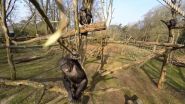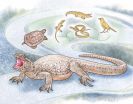(Press-News.org) AUSTIN, Texas -- Evidence from the tropical lowlands of Central America reveals how Maya activity more than 2,000 years ago not only contributed to the decline of their environment but continues to influence today's environmental conditions, according to researchers at The University of Texas at Austin.
Synthesizing old and new data, researchers were the first to show the full extent of the "Mayacene" as a microcosm of the early anthropocene -- a period when human activity began greatly affecting environmental conditions.
"Most popular sources talk about the anthropocene and human impacts on climate since the industrial revolution, but we are looking at a deeper history," said lead author Tim Beach, the C.B. Smith Sr. Centennial Professor of Geography and the Environment. "Though it has no doubt accelerated in the last century, humans' impact on the environment has been going on a lot longer."
By looking at Maya impacts on climate, vegetation, hydrology and lithosphere from 3,000 to 1,000 years ago, researchers propose that the Maya's advanced urban and rural infrastructure altered ecosystems within globally important tropical forests.
The researchers identified six stratigraphic markers -- or "golden spikes" -- that indicate a time of large-scale change, including: "Maya clay" rocks; unique soil sequences; carbon isotope ratios; widespread chemical enrichment; building remains and landscape modifications; and signs of Maya-induced climate change.
"These spikes give us insight into how and why Mayas interacted with their environment, as well as the scope of their activity," said Sheryl Luzzadder-Beach, co-author and chair of the Department of Geography and the Environment.
Maya clay and soil sequences indicated erosion, human land-use changes and periods of instability. Soil profiles near wetlands revealed heightened carbon isotope ratios due to agriculture and corn production; and researchers noted a three- to fourfold increase in phosphorus throughout Maya-age sediments.
However, the most visual indication of human impact was found in building material remains and landscape modifications. Researchers believe that these clues reveal how the Maya used water management to adapt to climate change.
"In studying the wetland systems, we were surprised to find a combination of human and natural contributions," Luzzadder-Beach said. "Geochemical changes indicated that some wetlands were natural, while others were built landscapes used to grow crops away from the large population."
The changes are both good and bad, researchers said.
"Historically, it's common for people to talk about the bad that happened with past environmental changes, such as erosion and climate change from deforestation," Beach said. "But we can learn a lot from how Maya altered their environment to create vast field systems to grow more crops and respond to rising sea levels."
While some studies suggest that deforestation and other land use contributed to warming and drying of the regional climate by the Classic Period (1700-1100 years ago), many existing forests are still influenced by Maya activities, with many structures, terraces and wetlands still existing today, researchers said.
"This work speaks to the deep history and complexity of human interactions with nature, and in a part of the world where we still have little knowledge about the natural environment," Beach said.
INFORMATION:
The study "Ancient Maya impacts on the Earth's surface: An Early Anthropocene analog?" was a collaboration between geography and the environment and anthropology researchers. It was funded in part by the National Science Foundation, the National Geographic Society, the UT Austin C.B. Smith Sr. Centennial Chair in U.S.-Mexico Relations, and the Cinco Hermanos Endowed Chair at Georgetown University. It will be published in the Quaternary Science Reviews this month.
In some patients, aggressive cancers can become resistant to chemotherapy and radiation treatments. In a paper published in the journal Nature Communications, University of California, San Diego School of Medicine researchers identified a pathway that causes the resistance and a new therapeutic drug that targets this pathway.
"It was previously known that RAF (a family of proteins that regulate cellular signaling) governs resistance to therapies. We discovered an undescribed role for RAF and learned precisely how it occurs in a broad range of cancers," said lead author ...
PHILADELPHIA -- Acupuncture may be a viable treatment for women experiencing hot flashes as a result of estrogen-targeting therapies to treat breast cancer, according to a new study from researchers at the Perelman School of Medicine at the University of Pennsylvania. Hot flashes are particularly severe and frequent in breast cancer survivors, but current FDA-approved remedies for these unpleasant episodes, such as hormone replacement therapies are off-limits to breast cancer survivors because they include estrogen. The results of the study are published this week in the ...
Montreal, September 3, 2015 -- Sleep matters for kids, especially when they are stressed. A new study led by researchers Jinshia Ly, Jennifer J. McGrath and Jean-Philippe Gouin from Concordia University's Centre for Clinical Research in Health and the PERFORM Centre shows that poor sleep might explain how stress impacts health in kids.
A good night's sleep
Getting a good night's sleep might buffer the impact of stress on kids' cortisol level, which is a hormone produced in the adrenal gland to regulate the body's cardiovascular, metabolic and immune systems. While short-term ...
Cool. Calm. And oh, so calculated. That's how a chimpanzee living in the Royal Burgers' Zoo in the Netherlands set out to swat an aerial drone that was filming her group. In an article in the journal Primates published by Springer, Jan van Hooff and Bas Lukkenaar explain it as yet another example of chimpanzees' make-do attitude to using whatever is on hand as tools.
The incident happened earlier this year, on 10 April, when a Dutch television crew was filming at the zoo in Arnhem. The idea was to use a drone to film the chimpanzees in their compound from different close-up ...
Amsterdam, September 3, 2015 - 3D imaging of a mummified kestrel that died due to forced overeating provides evidence that the ancient Egyptians bred birds of prey as offerings for the gods, according to a new study published in the Journal of Archaeological Science. The digital CT imaging revealed that the kestrel was force-fed its last meal - a mouse - suggesting it was kept in captivity.
This is the first evidence to point to mass breeding of raptors as offerings to gods. The researchers behind the study, from the American University in Cairo, Stellenbosch University ...
Amsterdam, September 3, 2015 - Elsevier, a world-leading provider of scientific, technical and medical information products and services, has announced that its Reviewer Recognition platform has launched a new functionality which enables reviewers to list their entire review history, including their reviews for non-Elsevier journals, in one place online. It also allows them to share their Reviewer Page publically - increasing visibility and recognition of their work.
Through the Reviewer Recognition platform, Elsevier reviewers already have access to a personal review ...
A 260-million-year-old fossil species found in South Africa's Karoo Basin continues to provide information into the murky origins of turtles whose evolution fascinates scientists.
The fossil of an extinct reptile, named Eunotosaurus africanus, is the earliest known branch of the turtle tree of life.
"Eunotosaurus is a critical link connecting modern turtles to their evolutionary past," says Dr Gaberiel Bever an Honorary Research Associate at Wits University's Evolutionary Studies Institute (ESI) and scientist at the New York Institute of Technology.
Previous studies ...
UK fisheries survey logbooks from the 1930s to 1950s have been digitised for the first time, revealing how cod responded to changing temperatures in the last century.
Scientists at the Centre for Environment, Fisheries and Aquaculture Science (Cefas) and the University of Exeter found that at the time, the warm seas experienced around Norway benefitted the cod, similar to the conditions there today.
Most cod eaten by the UK comes from northern seas including the Barents Sea around Norway, because the stocks there at the moment are at record highs. Cod stocks were also ...
Study examines trees in Leicester City
Pollution levels for pedestrians reduced by seven per cent in city environment
Highlights importance of trees in urban planning decisions
Trees in cities throughout the UK could be significantly improving the quality of the air we breathe by decreasing pollution levels for pedestrians, researchers from the University of Leicester have revealed.
The team from the University of Leicester's Department of Physics and Astronomy found that trees have a regionally beneficial impact by increasing turbulence and reducing ambient ...
In the first study of its kind, new research from the University of New Hampshire shows that crop rotations, in isolation from other management factors, can increase the functions performed by soil microbial communities that benefit plant growth. The study was conducted by researchers with the New Hampshire Agricultural Experiment Station.
The study was conducted by Lisa Tiemann, former postdoctoral student, Stuart Grandy, who was Tiemann's postdoctoral advisor, and Marshall McDaniel, former postdoctoral student of Grandy, all of the UNH Department of Natural Resources ...



